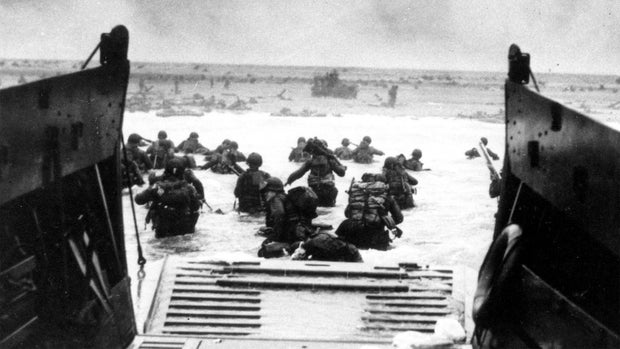On the eve of the D-Day invasion, General Dwight Eisenhower spent the remaining hours of the day with the paratroopers who were about to jump behind German lines into occupied France. A single moment captured by an Army photographer became the most enduring image of America’s largest military operation.
“It’s one of those images that makes you stop in your tracks,” said James Ginther, archivist at the Eisenhower Library in Abilene, Kansas. “There’s clearly something going on. There’s a conversation, but we don’t know what it is, and it invites us in.”
What makes this image so iconic (a crop of the famous photograph was even turned into a selfie station in the library) is that it perfectly captures everything that was at stake on D-Day – the burden of command and the lives in the balance.
US Army/Library of Congress
And the more you know about the image, the more perfect it becomes.
Asked why it was so important for Eisenhower to visit the troops the day before Allied forces landed in Normandy, Ginther responded: “Because wars are not won by armies. They are won by individual soldiers, and he knew the value of that. “
Wallace Strobel — the helmeted soldier in that photo — died in 1999, but recalled his brief encounter with Eisenhower in a 1994 interview with CBS News. “I was very young; it was my 22nd birthday,” he said. “We were really ready to go. We were all ready, we had everything loaded. And someone came running down the street and said, ‘Eisenhower is here!’ Well, everyone kind of said, ‘So what?’ We had more important things!”
No one caught their attention or got into formation. But then, Strobel recalled, “You could hear the excitement as he got closer. So we turned around and kind of looked outside, and then he got closer and at that point he stopped in front of me.”
Asked why Eisenhower, who commanded two million Allied forces in Operation Overlord, chose to speak to the paratroopers, Ginther said, “Because they are the key to the entire operation.”
The Germans flooded the areas behind the beaches and paratroopers were to jump ahead of the main landing force to seize the causeways leading inland.
CBS News
Strobel’s mission was to destroy the German guns that could turn these sidewalks into shooting galleries. He said: “They emphasized the fact: ‘Now, if you don’t get these weapons out by the hour, the whole damn invasion will fail.'”
What Strobel didn’t know was that a letter stamped “BIGOT” had landed on Eisenhower’s desk. BIGOT stood for British Invasion of German Occupied Territory. “It was higher than a top secret classification,” Ginther said.
Air Marshal Trafford Leigh-Mallory, the officer in charge of the airdrops, wrote, “I am very displeased with US Airborne Operations as now planned”, and warned that half of the 13,000 paratroopers could be lost.
In a 1964 interview with Walter Cronkite of CBS, Eisenhower recalled what Leigh-Mallory told him: “He was so sure that we were making a serious mistake that, about a day or two before the attack, he came to see me at the my camp, down here, and he was really sincere in his recommendations that we shouldn’t do that.”
From the Archives: CBS Reports (1964): “D-Day Plus 20 Years – Eisenhower Returns to Normandy” (Video)
It was a decision only Eisenhower could make. His response to Leigh-Mallory, hand-delivered the next day, said: “A strong air attack… is essential to the whole operation and must continue.”
It was, in Eisenhower’s words, a “soul-destroying” decision – but he gave no indication of that as he mingled with the paratroopers an hour before they boarded their planes.
So what exactly did the general tell Lt. Strobel? “He said, ‘Where are you from, Lieutenant?’ And I said, ‘Michigan.’ He said, ‘Oh, Michigan, I used to fish there.’
Martin asked, “So in that famous photo, they’re talking about fishing?“
“That’s what Wally Strobel says,” Ginther noted.
“It kind of changes my preconceptions about that photo. You look at it and think he’s saying, ‘Give them hell.’ Maybe he’s going just like he is in the cast?”
Strobel told CBS, “It was like he was trying to calm everyone down.”
Eisenhower later told Cronkite that the paratroopers tried to place he at ease too: “They were all getting ready and all camouflaged and their faces blackened and all that, and they saw me and recognized me and said, ‘Stop worrying, general, we’ll take care of it for you,’ and that kind of thing. It was a good feeling.”
A better feeling the next morning when the main landing force landed on the beaches of Normandy. “All preliminary reports are satisfactory,” Eisenhower cabled in his first dispatch. “The airborne formations apparently landed in good condition.”
It was too early to predict success, so Eisenhower closed by saying that he had visited the paratroopers the night before, “and the light of battle was in their eyes.”
See too:
GALLERY: D-DAY – When the Allies turned the tide
For more information:
Story produced by Mary Walsh. Editor: José Frandino.
mae png
giga loterias
uol pro mail
pro brazilian
camisas growth
700 euro em reais



























